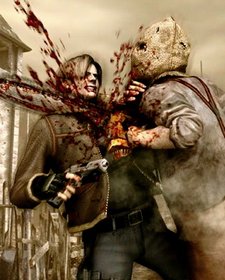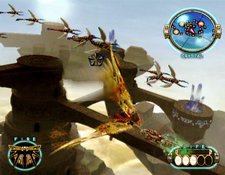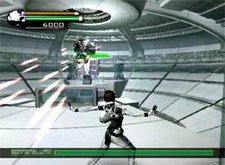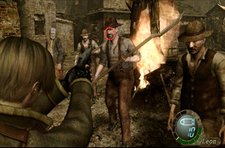 “The perfect game.”
“The perfect game.”
Our community often scoffs at the concept. Many argue perfection is unattainable, a Utopian mirage no game developer could ever reach. No game is entirely unblemished; there is always room for improvement, we argue, and there is always a flaw worth criticizing.
It almost seems an unwritten rule of gaming. The words of a writer who describes any game as “faultless” should be read with a certain degree of incredulity, particularly if s/he bestows a perfect score upon said game. Quite simply, there is no such thing as a “perfect 10.”
And as we scrutinize textures and analyze frame rates, reaching beyond the realms of practicality to invalidate perfection and justify a 9.6 review score, an irritated wave of antagonism toward sequels slowly spreads throughout our community. Speaking of unwritten rules, it is almost as if gamers are beginning to treat franchises as they would a passionate fling at the office.
The first time was great, and the second time was even better. But beyond that, things just start to get boring.
For any great developer, these beliefs are merely obstacles. They exist to be overcome by stunning software, not to become ingrained into the gamer psyche through a lack of falsification. Three years ago, Capcom refuted these stubborn presuppositions by releasing a truly spectacular game, undoubtedly destined to become one of the most revered video games in the history of our medium.
Rare is a game so remarkable that to levy criticism against it seems entirely pointless and unavailing. Perhaps even less common is a sequel that completely evolves its respective franchise and introduces it to a new audience while simultaneously providing its unmistakable apex. Resident Evil 4 is that kind of game, a timeless example of the staggering heights our industry can reach when it really wants to.
Yet in many ways, the magnificence of Resident Evil 4 remains a bittersweet achievement. For Capcom, there were greater casualties than zombies and evil villagers along the road to gaming history.
It began more than five years ago. In Nov. 2002, Capcom held a surprise press conference in Japan to announce five impressive new games exclusive to GameCube. For each of what would become infamously known as the “Capcom Five,” the publisher put its renowned Production Studio 4 at the helm, with Resident Evil creator Shinji Mikami providing oversight as general manager for each.
On its Web site, Capcom made a bold proclamation:
“For the growth of the gaming industry. For GameCube. These words describe our initial thoughts. In an industry where you create to amuse and entertain, do you sense a crisis about the industry’s continuing regression of excitement and new stimulation? We believe that the regression of excitement is solely the fault and responsibility of we creators. By the same token, we believe it is also our mission and responsibility to create something that is ‘worth seeing’ for the user. In a market that has become prosaic with character dependant games and sequel games, we would like to take this opportunity to announce five new and exciting games for GameCube.”
Such sweeping, epic statements can often signify empty rhetoric. But the “Capcom Five” were anything but hype-inducing publisher hyperbole. At least, they didn’t seem to be. Capcom’s announcement was not of the typically vague industry standard, outlining that at some undisclosed point in the future, some anonymous games would be releasing with features that “cannot be revealed at this time.” Quite the contrary, Capcom released gorgeous screens and videos of each project and detailed its unique vision for the “Capcom Five.”
Most importantly, the games looked stunning.
The first of the bunch was Viewtiful Joe, and if there were any indication Capcom was trying something special with the “Capcom Five,” this was it. What Capcom called a “beautiful side-scrolling action game,” Viewtiful Joe looked like a masterful next-generation revival of the classic 2D action formula. It was a daring move to develop a 2D console game in 2002, but clearly, Capcom had a vision.
The second was P.N.03, a futuristic third-person shooter absolutely brimming with style. A personal project of Mikami, P.N.03 was described as a mixture of Tomb Raider and Devil May Cry, pitting a sexy female protagonist in a violent world overrun by murderous machinery. Some prominent gaming outlets, including IGN, picked P.N.03 as the most promising title of the “Capcom Five.” And who could blame them? Early builds of the game looked remarkable.
 Next was Dead Phoenix, a particularly intriguing concept that put players into the role of a flying warrior soaring through ancient cities and ruins in the sky. Players would have to master intense aerial combat to survive in a landscape that was, according to Capcom, ever-changing. Many Nintendo faithful salivated over the premise, an obvious 3D nod to Nintendo’s own Kid Icarus series.
Next was Dead Phoenix, a particularly intriguing concept that put players into the role of a flying warrior soaring through ancient cities and ruins in the sky. Players would have to master intense aerial combat to survive in a landscape that was, according to Capcom, ever-changing. Many Nintendo faithful salivated over the premise, an obvious 3D nod to Nintendo’s own Kid Icarus series.
Fourth was the mysterious Killer 7, a project directed by then little-known developer Goichi Suda. Perhaps the most secretive title of the group, journalists were immediately perplexed by the game’s idiosyncratic approaches to virtually every aspect of presentation. There simply wasn’t much to compare Killer 7 to because, quite frankly, no one had ever seen anything like it.
And lastly, of course, was Resident Evil 4.
Capcom stated that each of the five GameCube exclusives would release in 2003. Resident Evil 4 was the only exception, boasting an ambiguous release date of “200X.” While an unspecified release date may seem a trivial detail, hindsight suggests something more. Perhaps the fact that Resident Evil 4 was an immediate exception was an omen of the unfortunate fate awaiting the other four.
Resident Evil 4 was originally placed under the guidance of Resident Evil 2 director Hideki Kamiya. Though the faces were familiar, however, it was anything but business as usual in the Resident Evil camp as development commenced for the fourth sequel. Capcom faced declining interest in its landmark survival horror series, and by the time Resident Evil 3: Nemesis released for the original PlayStation in 1999, commercial reception was at an all-time low for the acclaimed franchise. Attempted spin-offs, like Resident Evil: Survivor, were commercial and critical disappointments, and proper sequels were slowly becoming more predictable. Fearing Capcom’s landmark series was in danger of becoming boring and contrived, Kamiya began work on a Resident Evil game unlike any that had come before it.
But to Capcom, Kamiya had gone too far. Though his early build was impressive, Capcom felt Kamiya had strayed too far from the Resident Evil formula. He was taken off Resident Evil 4 development, but his project continued under a new name: Devil May Cry.
Capcom was back to the drawing board. Strike one.
When the “Capcom Five” started development in 2001, another version of Resident Evil 4 was set in motion. Known as the “Fog Version,” it was first shown at the 2002 Tokyo Game Show and set Resident Evil 2’s Leon Kennedy in a climactic confrontation with the Umbrella Corporation, and strange, fog-like masses, at its European stronghold. Below is the official trailer of the “Fog Version.”
[youtube]http://www.youtube.com/watch?v=ByVivES_PqU[/youtube]
All was going according to plan. Or at least, it seemed to be. But at E3 2003, Capcom showed another version of Resident Evil 4, having inexplicably scrapped the prior “Fog Version.”
Capcom was, again, back to the drawing board. Strike two.
The newest version of Resident Evil 4 established many changes that would survive to the final retail version. Though it featured the classic, fixed Resident Evil camera system, it pulled behind Leon for an over-the-shoulder view as he drew his weapon. It also introduced onscreen action button prompts during enemy struggles.
Fittingly dubbed the “Hooked Man Version,” it cornered Leon in an isolated mansion haunted by a ominous specter armed with a massive hook. At E3 2003, Capcom showed another trailer, shown below.
[youtube]http://www.youtube.com/watch?v=RgS_la-zKss[/youtube]
Gameplay footage of the “Hooked Man Version” is shown below.
[youtube]http://www.youtube.com/watch?v=upY_yiqUsNc[/youtube]
Clearly, Capcom had made substantial progress on Resident Evil 4, and given the series of changes the project had undergone, it was clearly a company priority. But Production Studio 4 still wasn’t satisfied, and they continued tinkering with the formula. The “Hooked Man Version” was scrapped because its plot and premise were, according to Capcom, too paranormal for a Resident Evil game. Given the living toy dolls and gruesome ghouls shown in the trailer, a traditionally minded Resident Evil fan might be inclined to agree.
But the “Hooked Man Version” was not a complete waste. Quite the contrary, its gameplay was absolutely on target, and much of how the version played was retained for the next build.
Capcom was again changing Resident Evil 4. Strike…three?
Perhaps not for Resident Evil 4 itself. But as Production Studio 4 continued to build new versions and scrap old ones, as they kept some aspects but altered others, and as the development process for Resident Evil 4 grew longer and more costly…what of the other four GameCube projects it was charged with?
One didn’t need to be an industry insider to see that there was trouble ahead for the “Capcom Five.” Not only was Resident Evil 4 taking steam from the other projects, but Capcom was suddenly faced with difficult financial decisions, as well. In Sept. 2002, the company announced it planned to lose more than $103 million during fiscal year 2002 due to poor sales and extended development cycles. As profitability became an increasingly large focus company-wide, budgets were adjusted to accommodate safer bets: specifically, the high-profile, high-priority Resident Evil sequel.
The rest, as they say, is history.
 P.N.03 was rushed to retail in Sept. 2003. It received generally mediocre reviews mostly due to unfortunate development decisions. The controls were stiff, and the levels were repetitive and often indistinguishable. Though there were redeeming qualities to the game, specifically the dance-to-dodge/cover-to-shoot gameplay aspects, they only served to highlight the overall disappointment, to underscore what could have been. Clearly lacking the original polish Shinji Mikami intended it to have, nearly everything about P.N.03 felt abruptly finished. An online posting by Mikami further suggested its development was rushed.
P.N.03 was rushed to retail in Sept. 2003. It received generally mediocre reviews mostly due to unfortunate development decisions. The controls were stiff, and the levels were repetitive and often indistinguishable. Though there were redeeming qualities to the game, specifically the dance-to-dodge/cover-to-shoot gameplay aspects, they only served to highlight the overall disappointment, to underscore what could have been. Clearly lacking the original polish Shinji Mikami intended it to have, nearly everything about P.N.03 felt abruptly finished. An online posting by Mikami further suggested its development was rushed.
“To be honest, after I finished (P.N.03), my feelings were…’I wanted to put a little more time into it,’ and a lot more,” said Mikami.
The other games of the “Capcom Five” faced similarly disappointing results. Cancelled before substantial development could begin, Dead Phoenix never made it to retail. Conversely, Viewtiful Joe and Killer 7 both survived development and were released. Though Killer 7 received mixed reviews, the unfortunate case of most games so purposefully daring, Viewtiful Joe was one of the most critically acclaimed games of 2003. But neither sold as well as Capcom had hoped on GameCube, and despite agreements with Nintendo and promises to fans, both were eventually ported to the PlayStation 2.
Resident Evil 4 finally launched Jan. 11, 2005, for the GameCube. But on Halloween 2004, only two months before the game’s release on GameCube, Capcom announced it would be porting the game to PS2, effectively stealing much of the GameCube release’s thunder.
The “Capcom Five,” five daring new GameCube games, had devolved into one mediocre exclusive, three PS2 ports and a cancelled project. Years have passed, but time has only proven that old wounds heal slowly. Some Nintendo fans are still bitter over the spoiled promises of the “Capcom Five,” and persistent rumors maintain that even Nintendo itself harbors aggrieved feelings toward Capcom over the loss of Resident Evil 4 exclusivity.
 Whether we buy into the concept of gaming “perfection” or not, most would agree that when a game like Resident Evil 4 releases, it is cause for celebration in our community. When a game’s strengths are so strong as to render its weaknesses – what few it may have – completely irrelevant and almost imperceptible, those who play games are reminded of the reasons for their enthusiasm for the medium. Petty criticisms and console allegiances aside, we have a purer form of fun with these games. They create memories, justify outlandish budgets and more than compensate for a $50 asking price.
Whether we buy into the concept of gaming “perfection” or not, most would agree that when a game like Resident Evil 4 releases, it is cause for celebration in our community. When a game’s strengths are so strong as to render its weaknesses – what few it may have – completely irrelevant and almost imperceptible, those who play games are reminded of the reasons for their enthusiasm for the medium. Petty criticisms and console allegiances aside, we have a purer form of fun with these games. They create memories, justify outlandish budgets and more than compensate for a $50 asking price.
But if Resident Evil 4 and the story of the “Capcom Five” proves anything, it is that perfection, or at least something analogous to it, almost always comes at a cost. For one timeless, arguably “perfect” sequel, we had to exchange the full realization of some intriguing, original concepts and exclusivity agreements.
Resident Evil 4 was, and always will be, an incredible ride. But there was a steep price of admission. And in our detail-obsessed, sequel-driven industry, there always will be.
